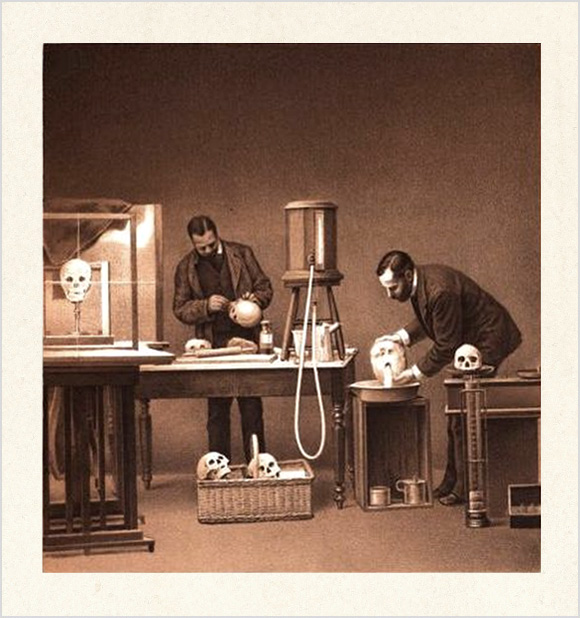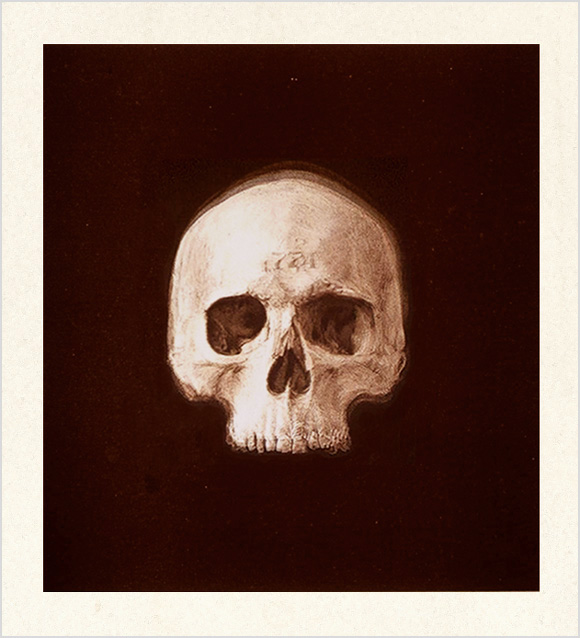

Journal : Memoirs of the National Academy of Sciences ; vol. III.; pt. 2 (13th Memoir).
Washington: Government Printing Office, 1885.
Description : 103-116 p., [20 l.] pl. ; ill: 20 photo-chromoliths., tbls. ; 30 cm.
Photographs : 20 photo-transfer chromolithographs of skulls, a craniophore, and procedures in craniometry.
Photographer : coauthor, Washington Matthews.
Subject : Cranium — Craniometry ; craniophore ; composite photography.
Notes :
The following letter from Francis Galton was published in Fielding Garrison's memoir of J. S. Billings (see Garrison, 1915, p. 250-251). The letter acknowledges a package of 20 composite photographs of skulls that Billings dropped off for Galton during a brief stop over in London on his way home to Washington. Galton was president of the Anthropological Institute of great Britian and Ireland and he presented the photographs to a meeting of the society on November 24th, 1885.
42 Rutland Gate, London S. W.,
November 13, 1884.
Dear Sir: I was most agreeably surprised by receiving your beautiful skull composites yesterday morning,
and laid them that very evening before the Anthropological Institute. The negro seems extremely good and testifies to the
great similarity of its constituents, just as the European skull does to their diversity. You must have found it difficult,
as I did, to arrange so that they should be superimposed with the utmost probable justice. The difficulty with skulls is
two-fold greater than with facesó(1) because there are no sharp fiducial lines equivalent to those that may be drawn through
the pupils of the eyes, through the mouth, and vertically (in a full face) through the midway point between the two pupils;
and (2) because the part of interest is the outside rim and not the inner parts so that any misfit is the more conspicuous.
I fancy it might lead to even better results if, after fixing each skull successfully in place, a very small additional
adjustment were made to bring the real skull in the most exact probable accordance with a fiducial image. What that image
should be, is a question to be answered best by the operator, according to the facilities of his laboratory. Our plan would
be to outline the image of the first skull on the focussing glass of the camera (the ground part would have to be on the
outside) and adjusting all the others by that. The plate holder would have of course to be closed and withdrawn after each
exposure, but in a well-made camera, and with a tension to the tight fit of the plate in the plate-holder by a paper wedge,
I don't expect any sensible error would result from their frequent removal and replacement. Another plan would be to
photograph through an oblique plate of plane and parallel worked glass on which a "Pepper's ghost" of a fiducial skull could
at will be thrown by a strong side illumination to be arranged as most convenient. I always found it well to expend a great
deal of trouble to get the most profitable adjustment of the images.
I was very sorry to miss the pleasure of seeing you when you were in town. It so happened that the first day that I heard of your address was that on which you were to leave. It would have been a great pleasure to me to have shown you my various instruments in various states of completeness and gain the advantage of your suggestions and criticisms.


The richly colored plates were produced by the gifted German immigrant lithographer, Julius Bien, whose reissue of Audubon's aquatints are prized by collectors. To reproduce Matthews's photographs, he screened the negatives onto photo-transfer paper, serving to transfer the images to limestone blocks. After they were burned in the blocks, the images were then extensively retouched by litho crayon. Bien's studio prospered for over 50 years and he was a founder and first president of the National Lithographers Association.
On November 12, 1884, Billings delivered four sets of Dr. Matthews's composite photographs of skulls to Francis Galton, the originator of anthropometric composite photography. Besides the skulls of Arapahoe indians and Sandwich Islanders that were published in the Memoirs, the portfolio also included composite photographs of "Whistitaw Indians" and "Ancient Californians." An extract from a note that Billings attached to the portfolio was published by Galton in volume xv of the Journal of the Anthropological Institute of great Britian and Ireland (1886, p. 391):
"It required much more time than I had anticipated to work out a satisfactory method. I think we are now ready to prepare composites from those crania in our collection which are suitable for such a process. I send you herewith by mail & package of such composites, and also photographs of the craniophore we now use. The adjustments are made by means of vertical and horizontal threads stretched on folding frames, and a full description will appear in the next volume of Transactions of the National Academy of Sciences. All are made exactly half the natural size, and after trying several other scales I think this is the one best suited to composite photographs of crania."
